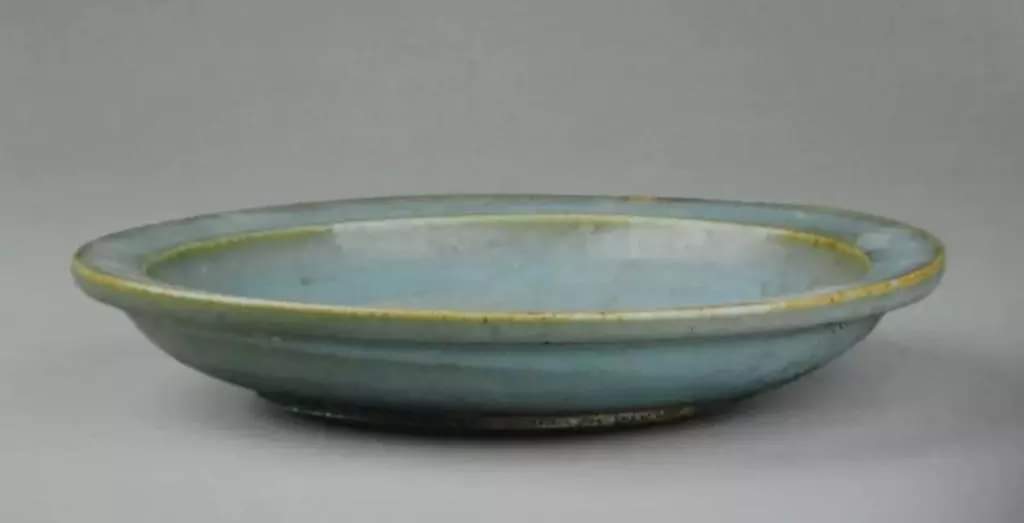
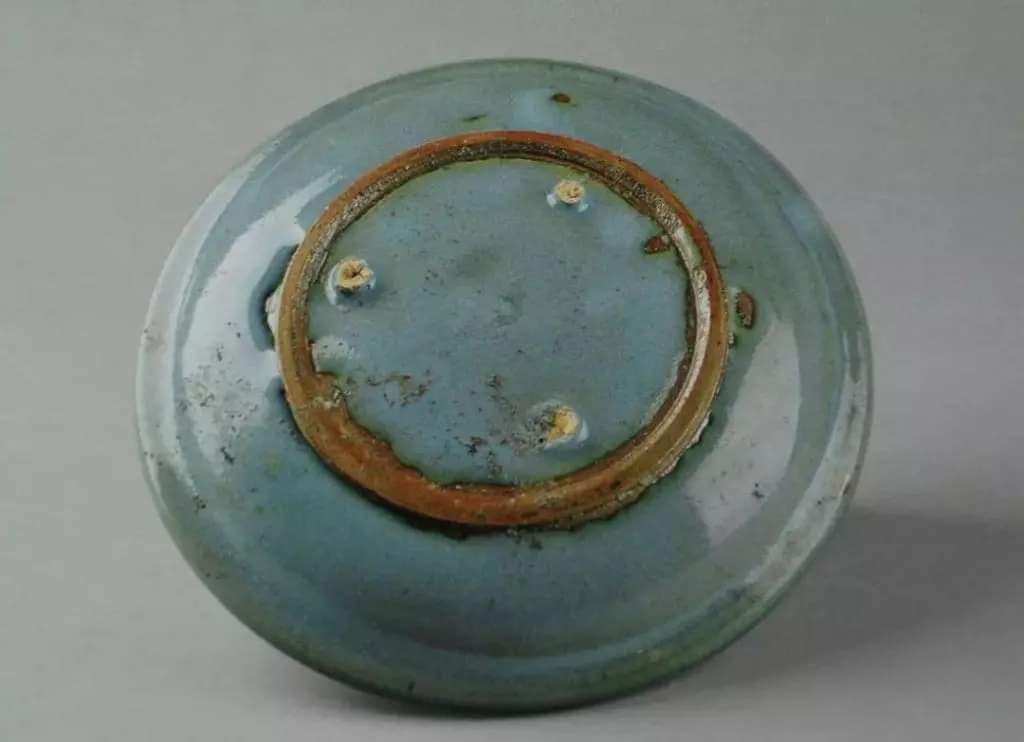
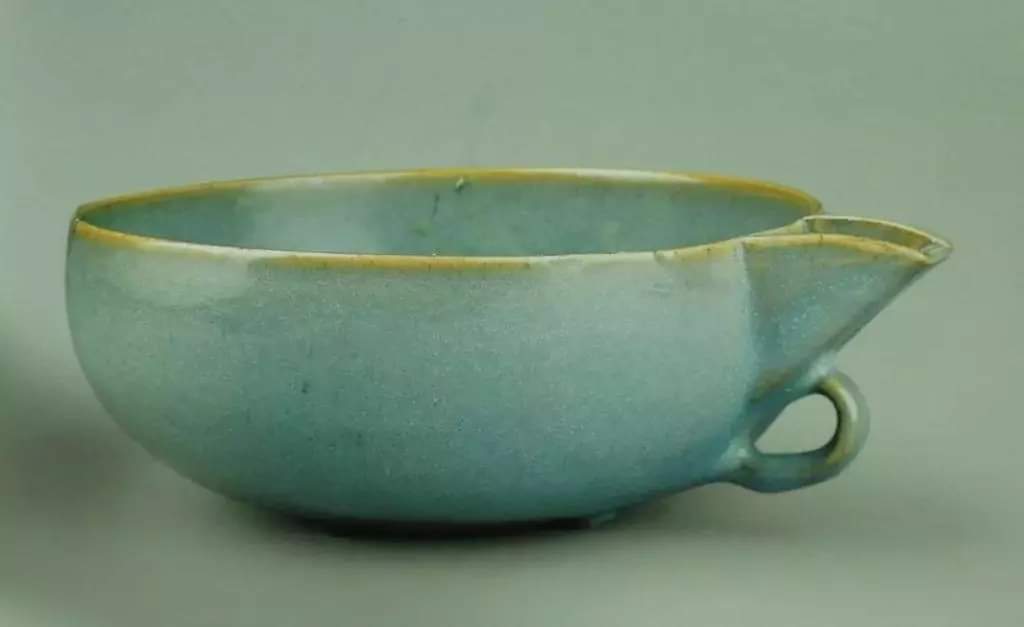
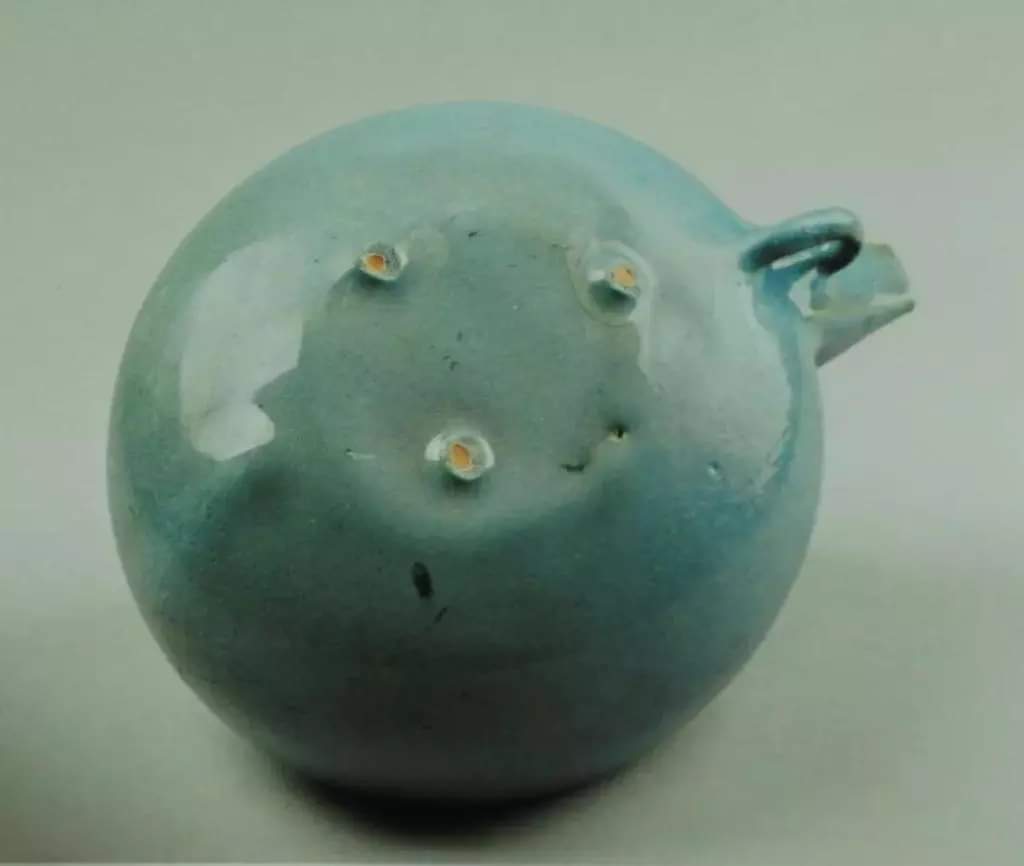
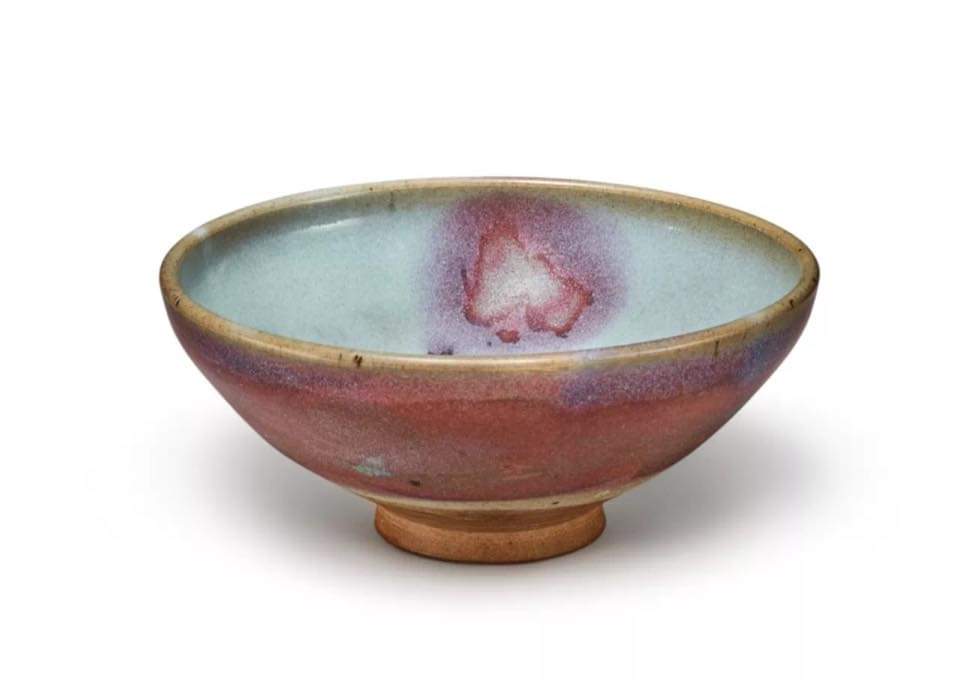
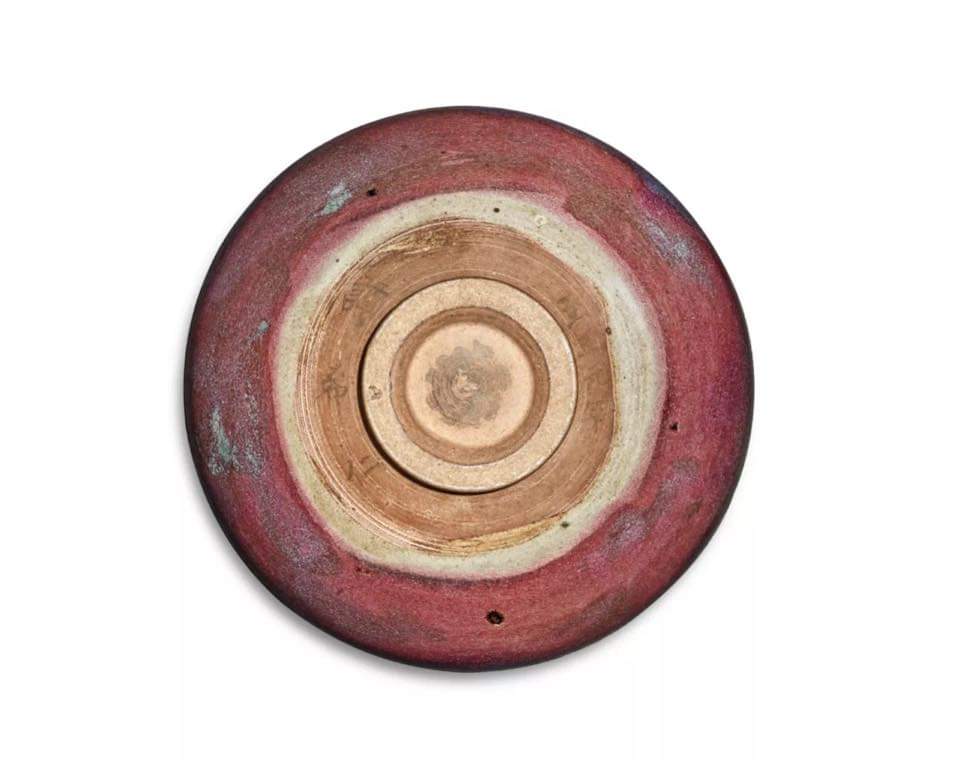
Song Porcelain
The Song Dynasty saw the introduction and flowering of many new folk kilns ceramics form and Imperial Court's involvement in the production of ceramics for the palace use.
Song porcelain ware is an epitome of aesthetic perfection. Generations of potters have drawn and will continue to draw inspirations from Song ceramics creations. The elegance of the shape of the vessels achieved was superb. The aesthetic beauty of jade -like celadon glaze of ru/guan/longquan reached unsurpassed perfection and delicacy. The icy bluish beauty of Qingbai glaze has enchanted generations of porcelain collectors. The carved/impressed decorations of Ding and Yaozhou wares reigned supreme.
The ingenuity and creativity of the Cizhou and Jizhou potters was also amazing. They were able to overcome the limitations of poor quality raw material for porcelain making and came out with innovative and aesthetically wonderful products. The use of white slip to whiten the body and further using it as a decorative element for sgraffito design was brilliant. Building on the foundation of the celadon underglaze iron-pigment brown/black decoration of the earlier era, the cizhou kilns fully developed the underglaze iron-pigment motif on white ground. It became a main-stream product until it was overtaken by blue and white in the Ming dynasty and marginalised in the Qing Dynasty. The jizhou potters were able to work on a combination of dark and a lighter colour glaze to achieve great products such as the tortoise's shell/tiger's fur effect and paper cut motifs.
The potential of the copper oxide was finally realised in the dazzling beauty of rainbow-like purplish/red splashes on blue ground of Jun wares. The ever inexhaustible potential of iron-pigment for amazing decorative effect was proudly displayed in the form of the temmoku hares' fur and oil spots.
It was also a period of commercial liberalisation and huge growth in overseas trade which was encouraged by the imperial court as a source of substantial tax revenue. An important development was the large number of kilns that were set up in the coastal region in Guangdong and Fujian to produce porcelains for the Southeast Asia market.
Guangdong kilns, with Xicun being the preeminent example, initiated an important ground-breaking new business approach of diversification based on replicating the successful products of other kilns. During the pre-Song period, individual kilns generally focused and specialised on producing their line of unique product, such as Xing white ware, Yue greenware, Changsha polychome decoration and etc. This business model was inherited by the Fujian kiln operators which produced mainly Longquan inspired celadon and Jingdezhen inspired substitute wares. They constituted the bulk in the cargo of some known Southern Song wrecks such as Nanhai 1 wreck, Java wreck, Jepara and etc.
For more on Guangdong and Fujian trade ceramics, please read below:
Tang/Song Guangdong trade ceramics
Song/Yuan Fujian trade ceramics
Song Jun, Ru and guan wares
In the area of ceramics production, an important development was the setting up of official kilns to produce ceramics for the Imperial palace. During the Northern Song period, Jun and Ru wares , both a form of celadon, were produced.
The Jun kilns at Baguadong (八卦洞 )and Juntai (钧台)were located in Yu county (禹县) in Henan. The Jun kiln used iron and copper oxides to fire an opacified bluish glaze with red or purplish splashes. Vessels included flower pots, washers, dishes, censor, bowls, zun and etc.
Some of the flower pots/stands have number (1-10) carved on their base. It has been established that the number is an indication of the size. Some vessels also have inscription such as fenghua (风华). But the category of Guan Jun is still a controversial subject and the views is verging towards a Yuan/Ming.
 |
 |
| Jin Jun dish |
 |
 |
| Jin Jun washer |
 |
 |
| Jin Jun bowl with copper red spashes |
Folk kilns in Henan also produced Jun wares but the number of Song/Jin wares excavated were relatively small in number as compared with those produced during Yuan period. The best Jun from the folk kiln were produced at Liu Jiamen (刘家门).
Ru wares were produced in Baofeng Qingliangsi (宝丰清凉寺) in Henan. They usually have a light sky-blue colour with tiny spur marks on the outer base. Vessel forms consisted of mainly dishes, washers, bowls and some archaic zun vase, lian-form censers and vases. Some vessels also have the inscription fenghua (风华).
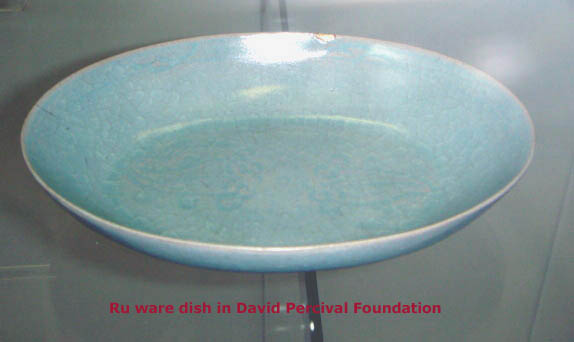 |
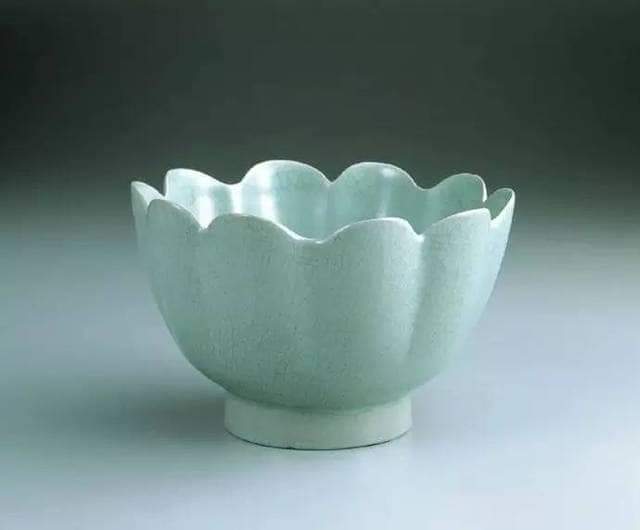 |
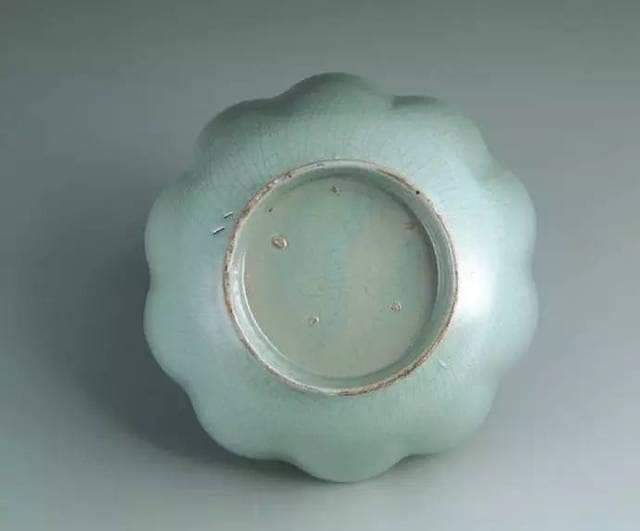 |
| Song Ru bowl in Taipei Palace Museum |
During the Southern Song Period, two officially operated kilns were built at Xiuneisi and Jiaotanxia with the former in operation first. They consisted of jade-like thick which powdered bluish or yellowish colour tone. They have iron black body with majority having crackled glaze. The best have very thick multi-layered glaze and biscuit think body.

For more on the guanwares, please read : Song Guan Wares.
Yue/Longquan greenware (celadon)
During the Northern Song period, Yue ware was still an important greenware. The products of this period is characterised by fine incised motifs covering floral, bird, phoenix, dragon and human motif. A form of more deeply carved combined with incised style of decoration was introduced during the Mid Northern Song Period and continued to be used during the rest of the Northern Song Period. Yue greenwares essential ceased by early Southern Song period.
For more on Song Yue ware, please read this article.
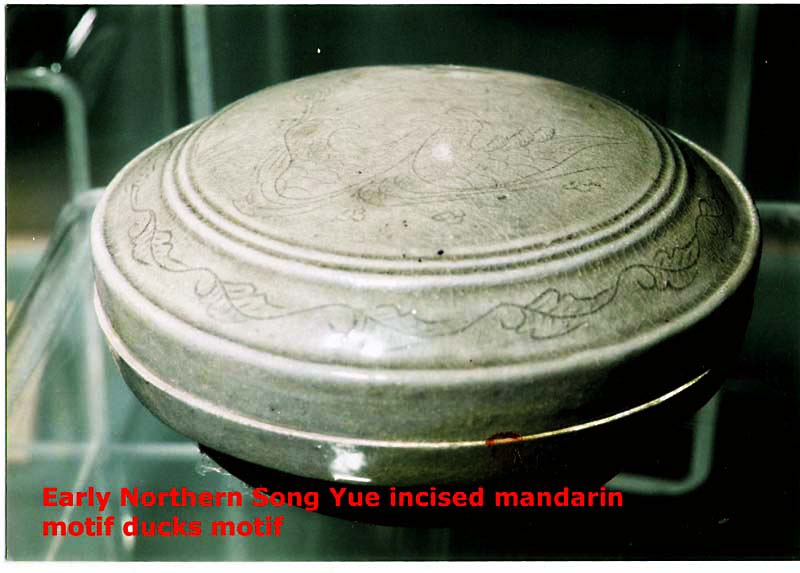
Longquan of the Northern Song essentially copied the Yue carved/combed design.
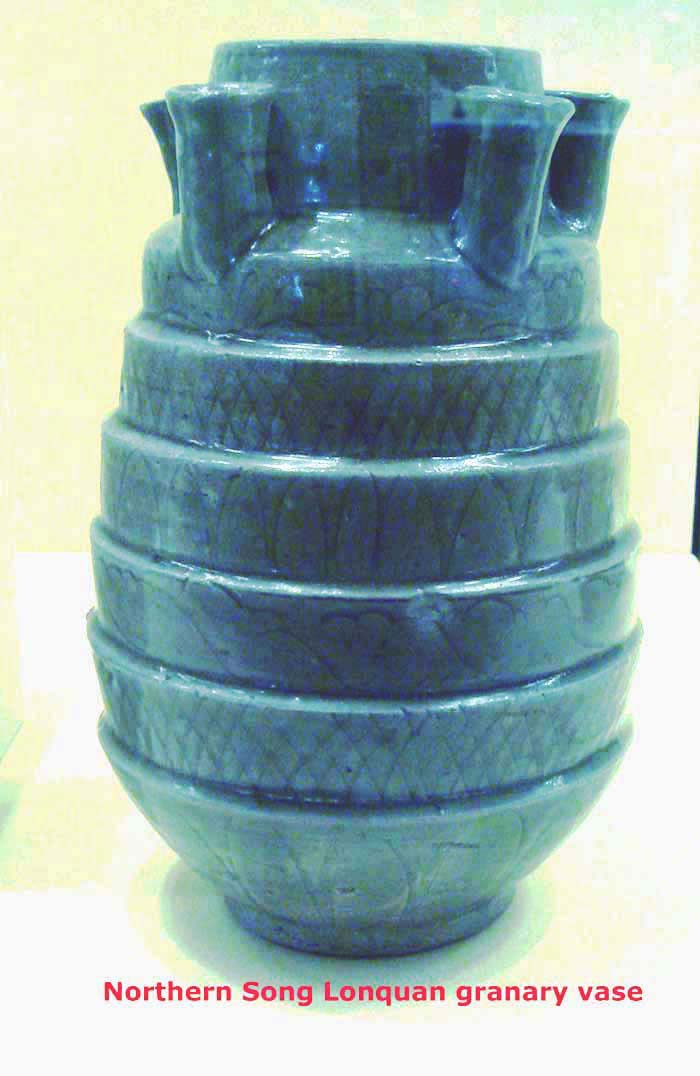
Longquan developed its famous powder green and plum green glaze towards the end of Southern Song period. The ware is characterised by multi-layered glaze application with jade like quality. It is arguably the greatest achievement of all green glaze wares. Longquan potters also produced some guan-type black body wares during the late southern Song period.
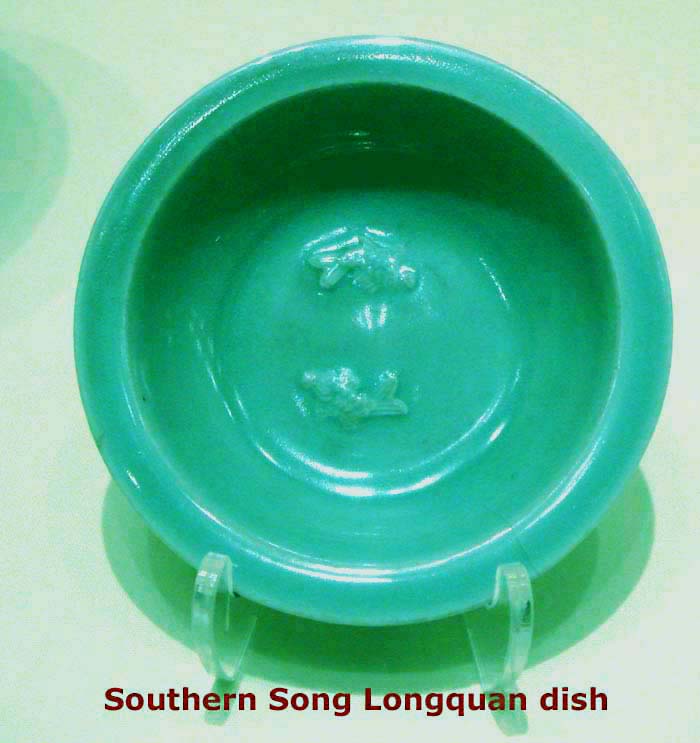 |
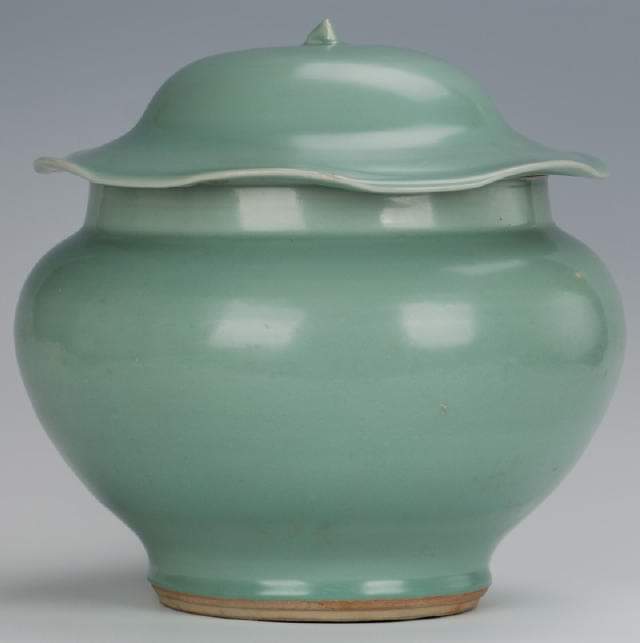 |
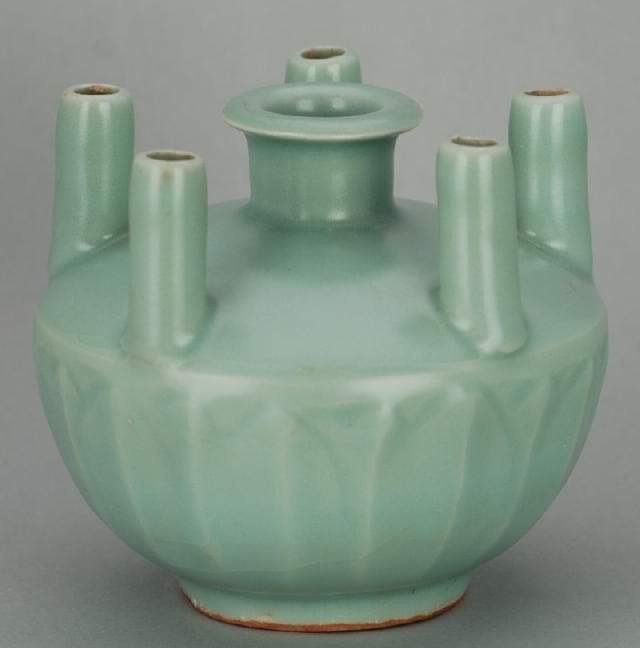 |
| Two Southern Song Longquan celadon vessels from the Sichuan Suining Hoard |
The carved/combed motifs longquan motif was widely adopted by the Fujian kilns during the late Northern Song/early Southern Song period. It was an important export item and was termed Tongan type greenware or Juko (shuko seiji) greenware in Japan. Shuko was a Japanese monk who was known for his preference for Tongan type greenware for tea ceremony.
For more on Longquan celadon, please read: Longquan Celadon
For more on Longquan influenced Fujian greenware, please read: Fujian Trade Ceramics
Yaozhou Greenware
Yaozhou established itself as the greatest Northern Celadon (greenware) production centre during the Northern Song Period. The most famous was the Huangbao site at Tongchuan in Shanxi . But the kiln sites included Chenluzhen, Lidipo and Shangdian. Yaozhou greenware was famous for the carved motif with strong 3 dimensional visual effect. An interesting characteristic of Yaozhou ware is the ginger-yellow scotched marks on the base and at the foot. After Mid Northern Song, elaborate impressed motifs were introduced and gradually became the more dominant products. The repertoire of impressed motif is varied and consist sof flowers, dragon, phoenix, fish, makara, flying fairies, infants and etc. Yaozhou greenware continued to be produced during the Jin period and gradually ceased during the Yuan period. During the Jin period, an important Yue bai (moon-white) glaze was introduced.
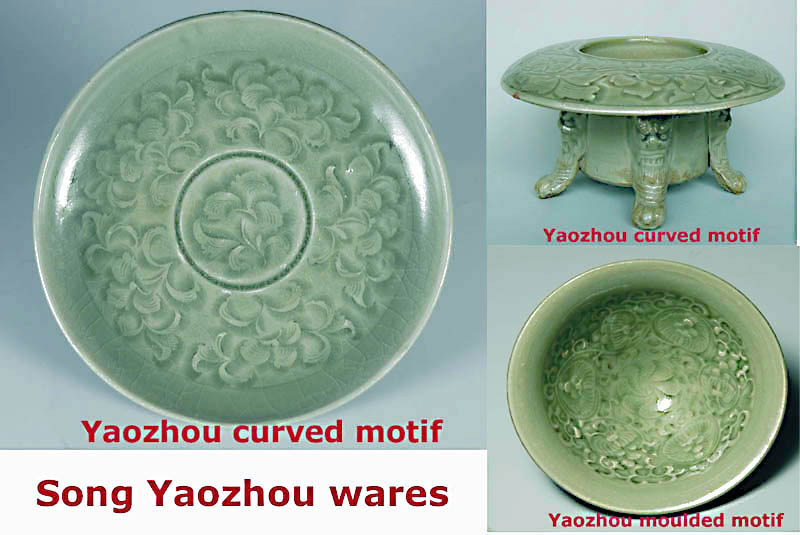
Yaozhou type greenwares were also produced in Henan kilns such as those in Linru, Xinan Cheng Guan and Baofeng. They are very similar to the Yaozhou production but are generally of poorer quality.
For more on Yaozhou greenware, please read: Yaozhou Celadon
Ding ware
Ding kiln was located in Jiancicun in Quyang county. The kiln started production during the Tang period and achieved great fame during the Northern Song and Jin period for its ivory white glaze and finely carved and later even more famous impressed motifs. It was at one point an important tribute ware to the Imperial court during the Northern Song period.
One of the most important contributions of the Ding potters was the invention of the inverted firing Method. It was subsequently adopted by many kilns including Jingdezhen.This method enabled more pieces to be fired in the kiln. It however required the removal of glaze at the rim.
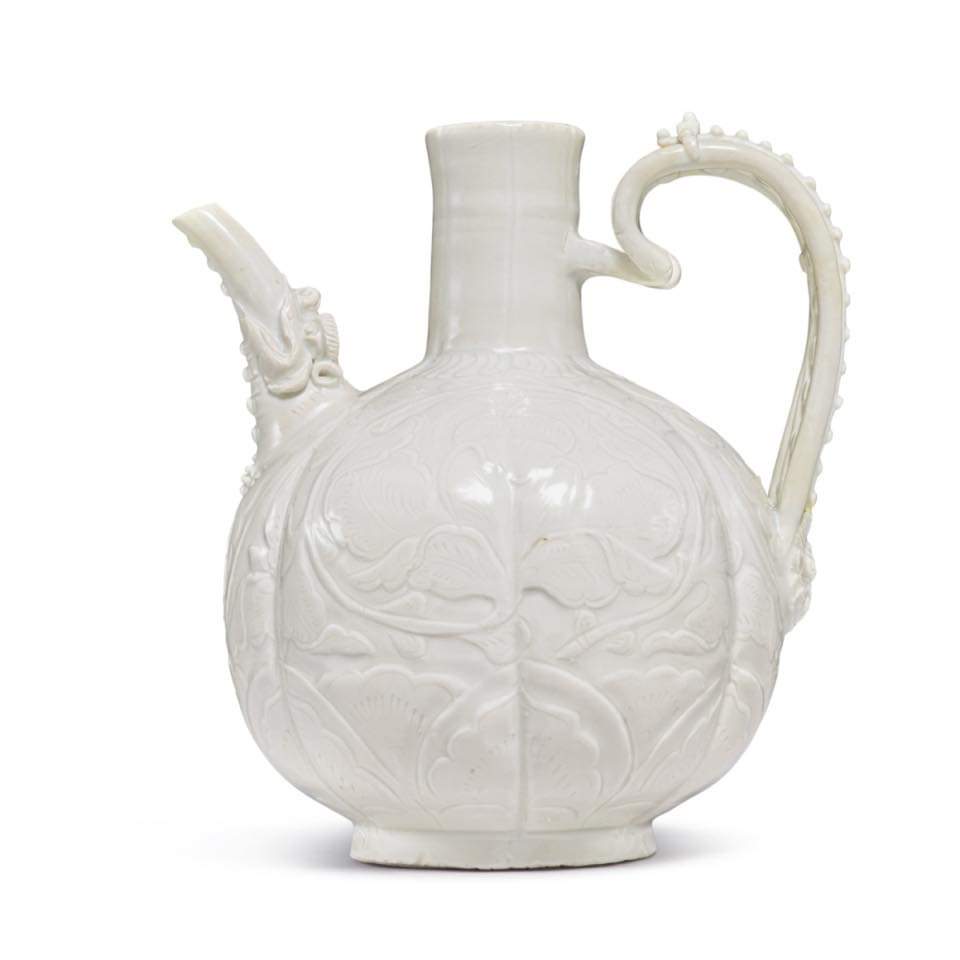 |
| Song Ding ewer with carved floral decoration |
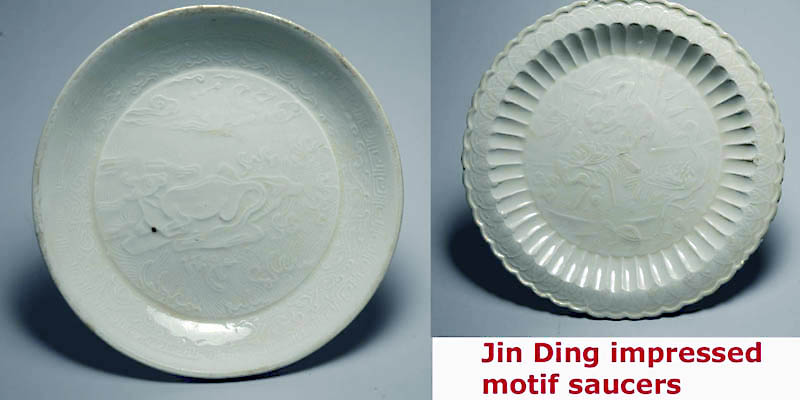
Important Ding type white wares were made in Pingding in shanxi province.
For more on Ding ware, please read: Ding ware
Qingbai (Yingqing) ware
Qingbai meaning bluish white ware, was probably first produced in Anhui Fanchang during the 5 Dynasties period. However, it was Jingdezhen that further improved on this genre during the Northern Song period. The best Qingbai wares were produced in Hutian kilns near Jingdezhen. The carved motif on Northern Qingbai wares was excellent. The pooling of the bluish glaze in carved area of the motif enhances and bring out the profile of the motif nicely. Impressed motifs were popular during the Southern Song and Yuan Period. The glaze became more bluish during Southern Song and gradually became more opaque especially during the Yuan period.
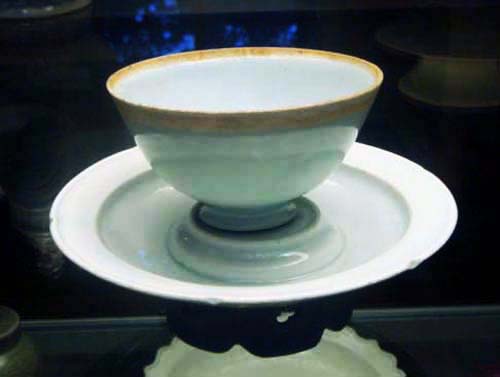
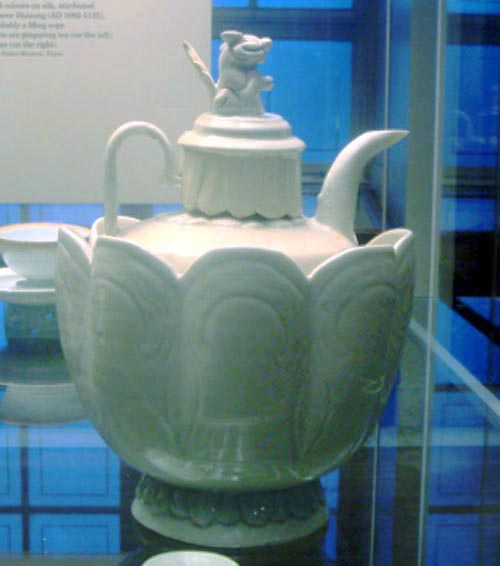
Qingbai wares in British Museum
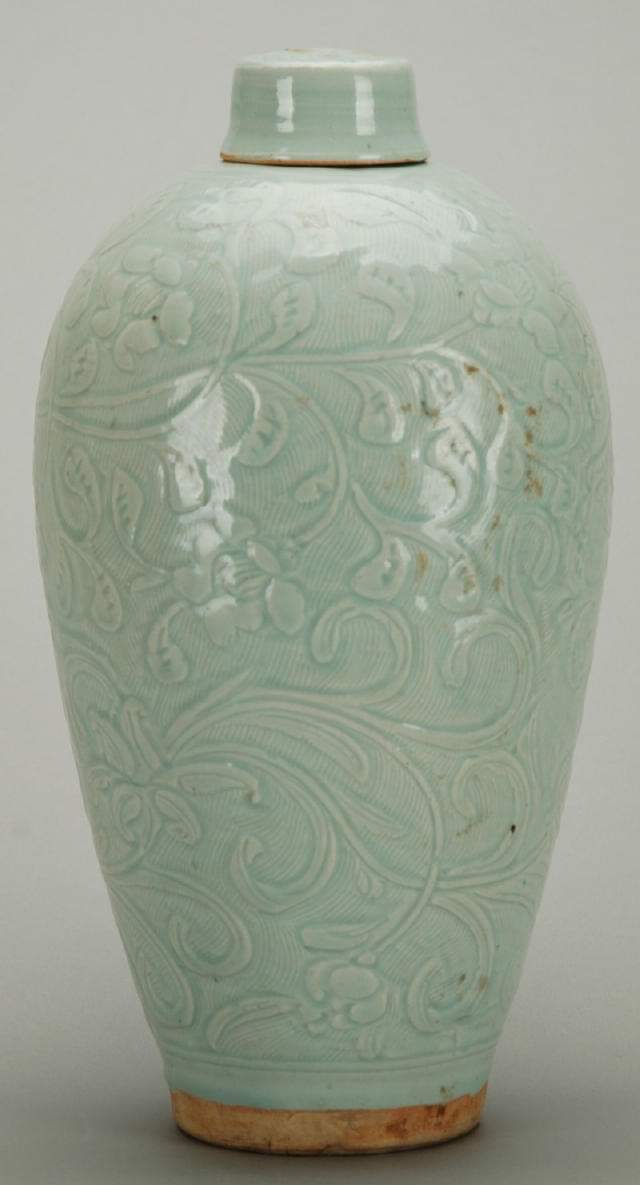 |
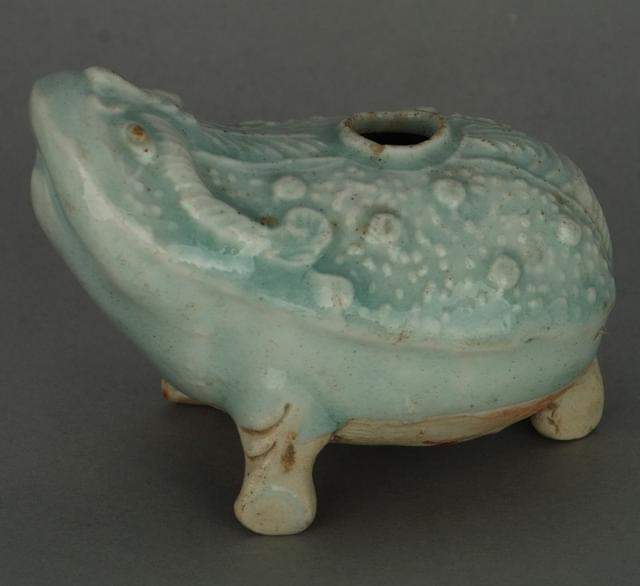 |
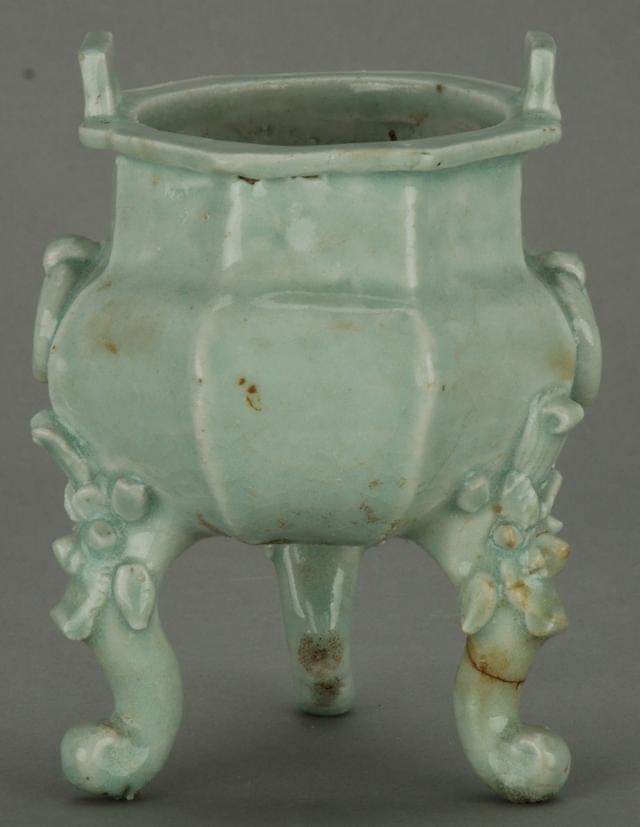 |
| 3 Jingdezhen Qingbai vessels from the Sichuan Suining Hoard |
Qingbai was an enormously popular product and were produced in numerous kilns in Jiangxi in areas around Jingdezhen, Nanfeng and Jizhou and also provinces such as Anhui, Zhejiang, Fujian and Guangdong.
Qingbai wares were exported overseas in large volume during the Song/Yuan period.
For more on Qingbai ware, please read: Qingbai (Yingqing) wares
Cizhou ware
The earliest ancient text which commented about Cizhou wares was Ming period (曹昭) Cao Zhao's Ge Gu Yaolun ( 格古要论). He wrote that the good ones are similar to Ding ware but without tear marks. There were also those with incised or iron rust colour painted motifs. The ancient texts were vague and did not give a clear picture of the types of Cizhou wares which were made before Ming period. Hobson was the first to identify those wares found in Julu as wares made in ancient Cizhou and suggested the term Cizhou type wares to classify wares that share common key features. The typical cizhou ware has a milky white glaze. It utilises one of the following decorative techniques: carved, incised, incised/combed motif, sgraffito motif which involved shaving away the slip outside the incised motif to create an embossed or paper-cut effect and thirdly iron black/brown painted or overglazed enamelled red/green/yellow motifs. Some of the wares were covered with a green or torquoise colour glaze. There is also the sancai type which utilised low fired lead glaze white, green and yellow colour.
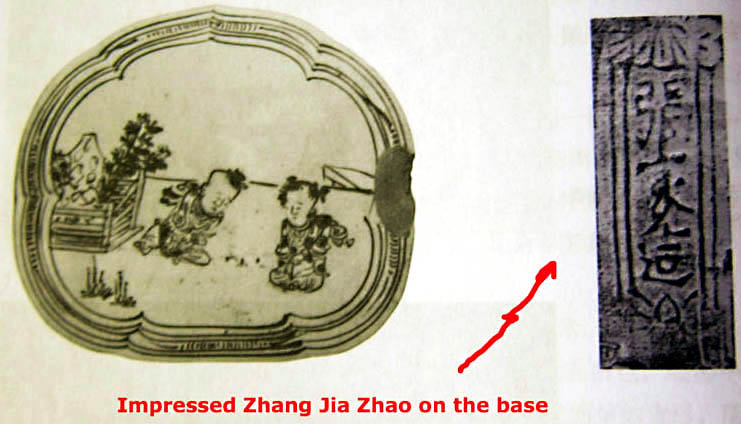
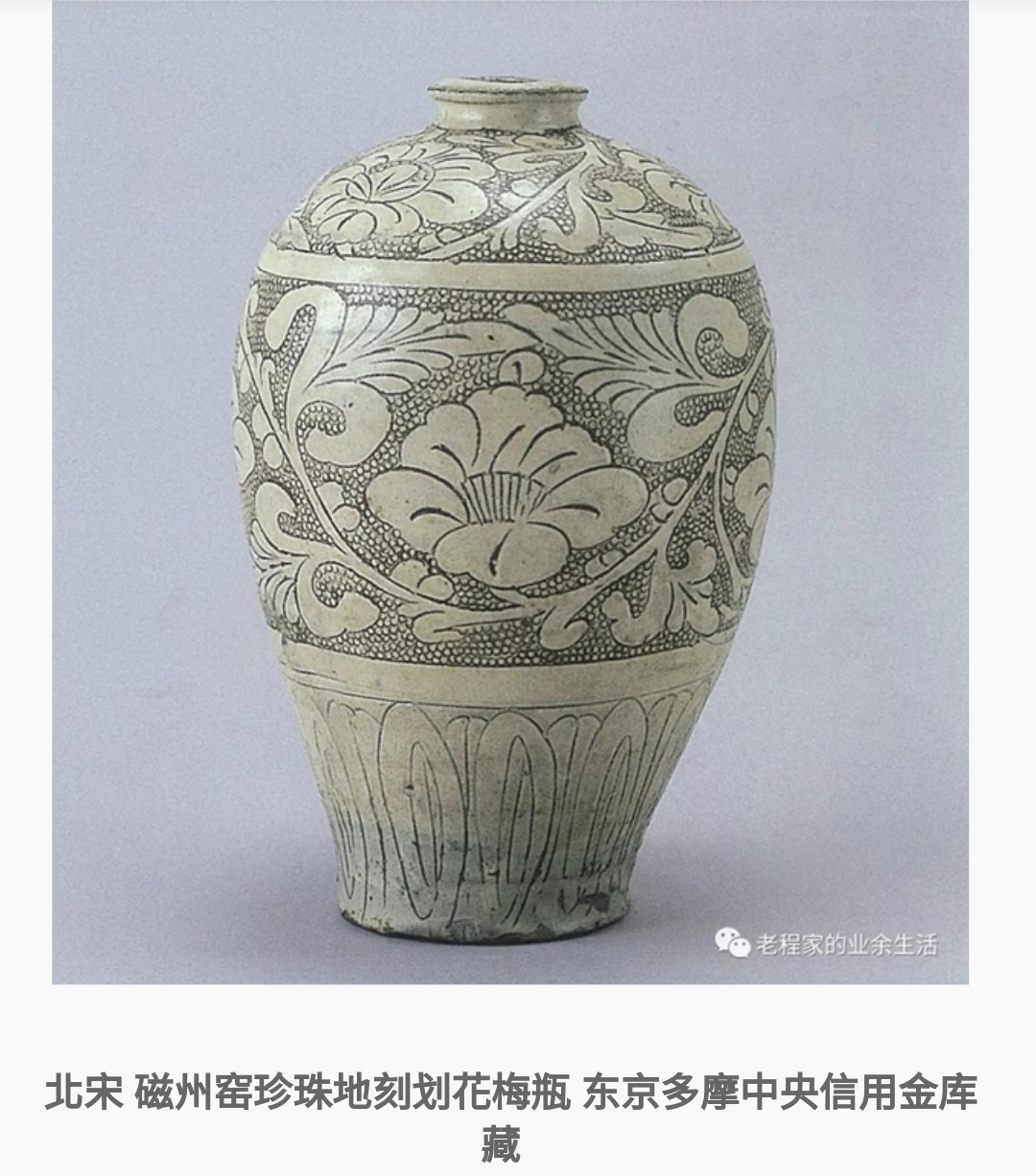 |
| Northern Song Cizhou Meiping with carved floral decoration on pearl's ground |
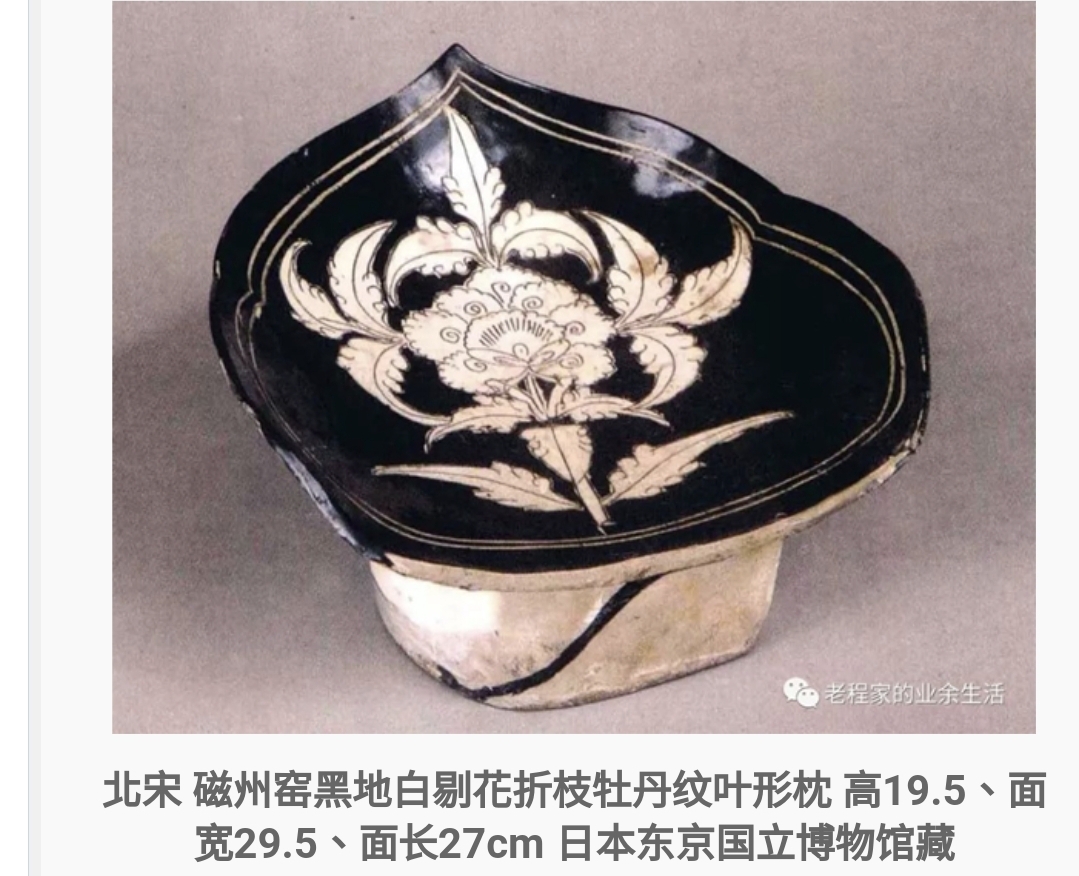 |
| Northern Song Cizhou pillow with sgrafitto decoration |
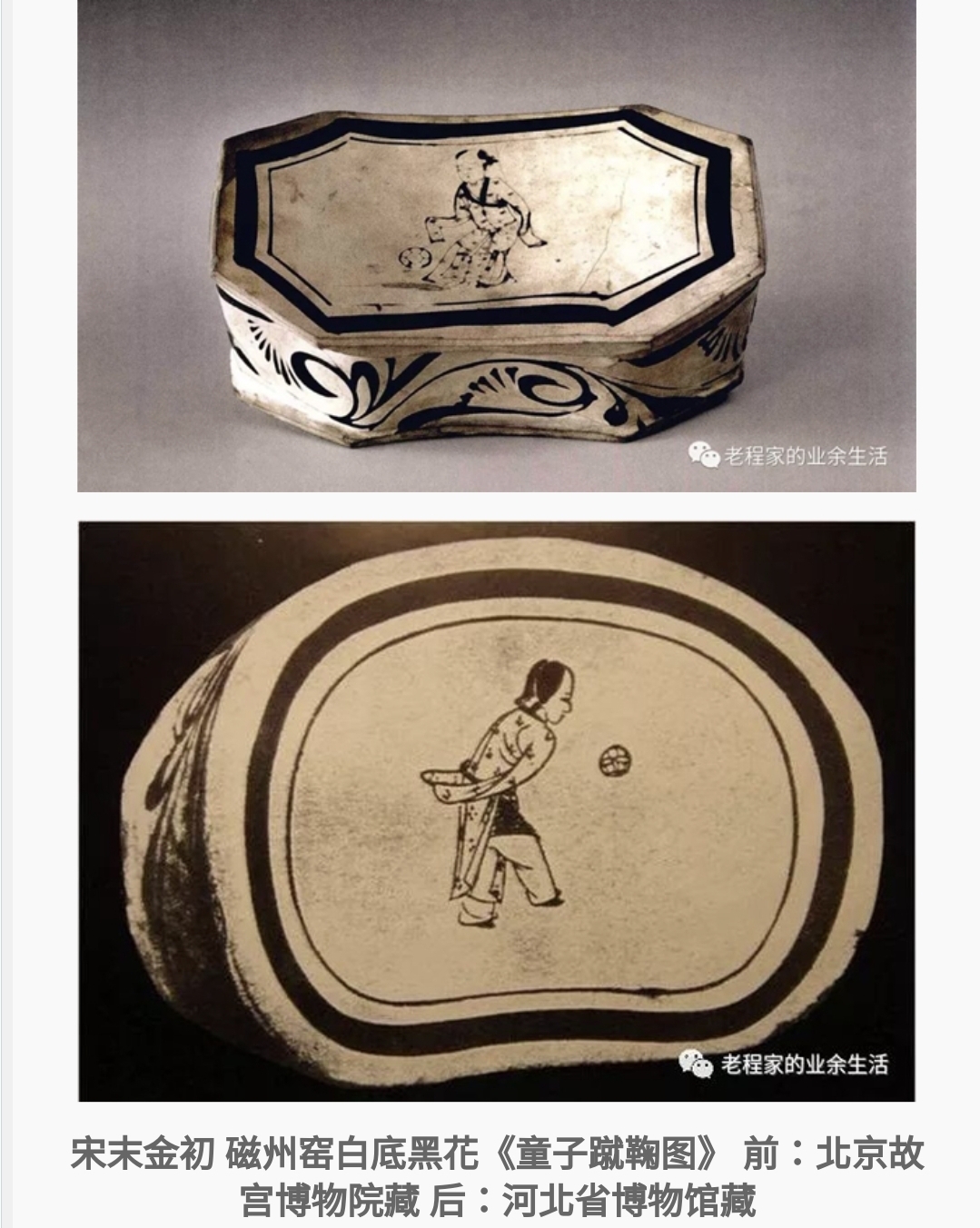 |
| Song/Jin Cizhou pillow with iron-black painted infant decoration |
There are numerous other kilns located in Hebei, Henan (some famous ones such as Dangyangyu ,Hebiji ,Dengfeng) , Shanxi yaozhou , Ningxia Lingwu, Inner Mongolia Chifeng , Shanxi Jie xiu and ping ding , Shandong, Anhui, Jiangx and Jizhou which produced similar wares. There are definitely some local stylistic decorative differences and also in terms of shape/form and glaze and paste appearance. Yet one can still discern that they are unmistakably cizhou in character especially in terms of the dec,tive techniques. Hence, they are widely termed as cizhou type wares.
Dangyangyu kiln in Henan also produced a famous marbled ware. It is also termed wood grain, pheasant's wing or feather pattern. Other Henan kilns producing such product included Qingliangsi in Baofeng and Chengguan in Xinan.
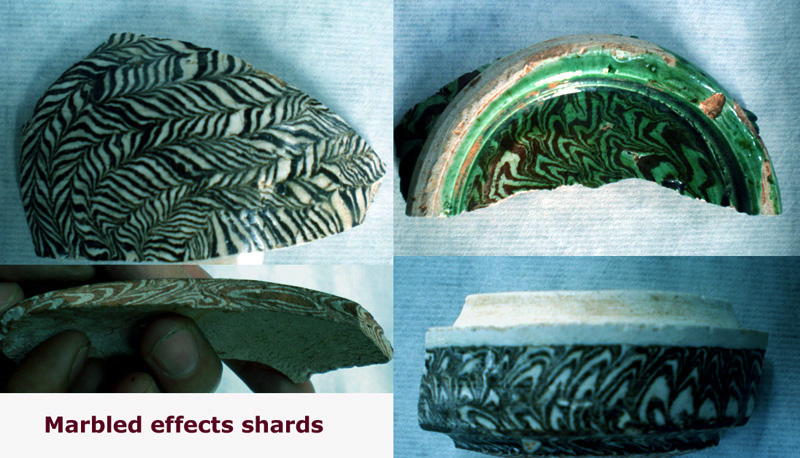
The overglaze enamelled red, green and yellow motif on white glaze ware was an important new decorative type introduced during the Song period. Most extant pieces were from the Hebei cizhou, Henan pacun and Shanxi Changzhi and shandong zibo kiln. The decoration was drawn on the high fired white glaze vessel. Upon completion, it went through a second low firing of about 800 degree centigrade to adhere the enamels to the white glaze surface. The vessels consisted of mainly bowls, dishes and human figurines. In fact, black enamel was used for the eye brow and eyes of figurines from pacun kiln.
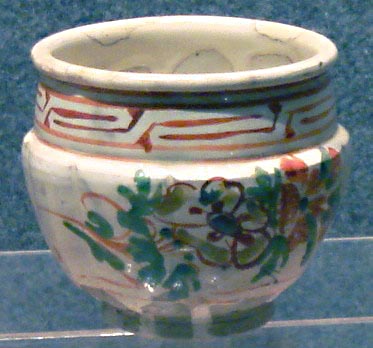 |
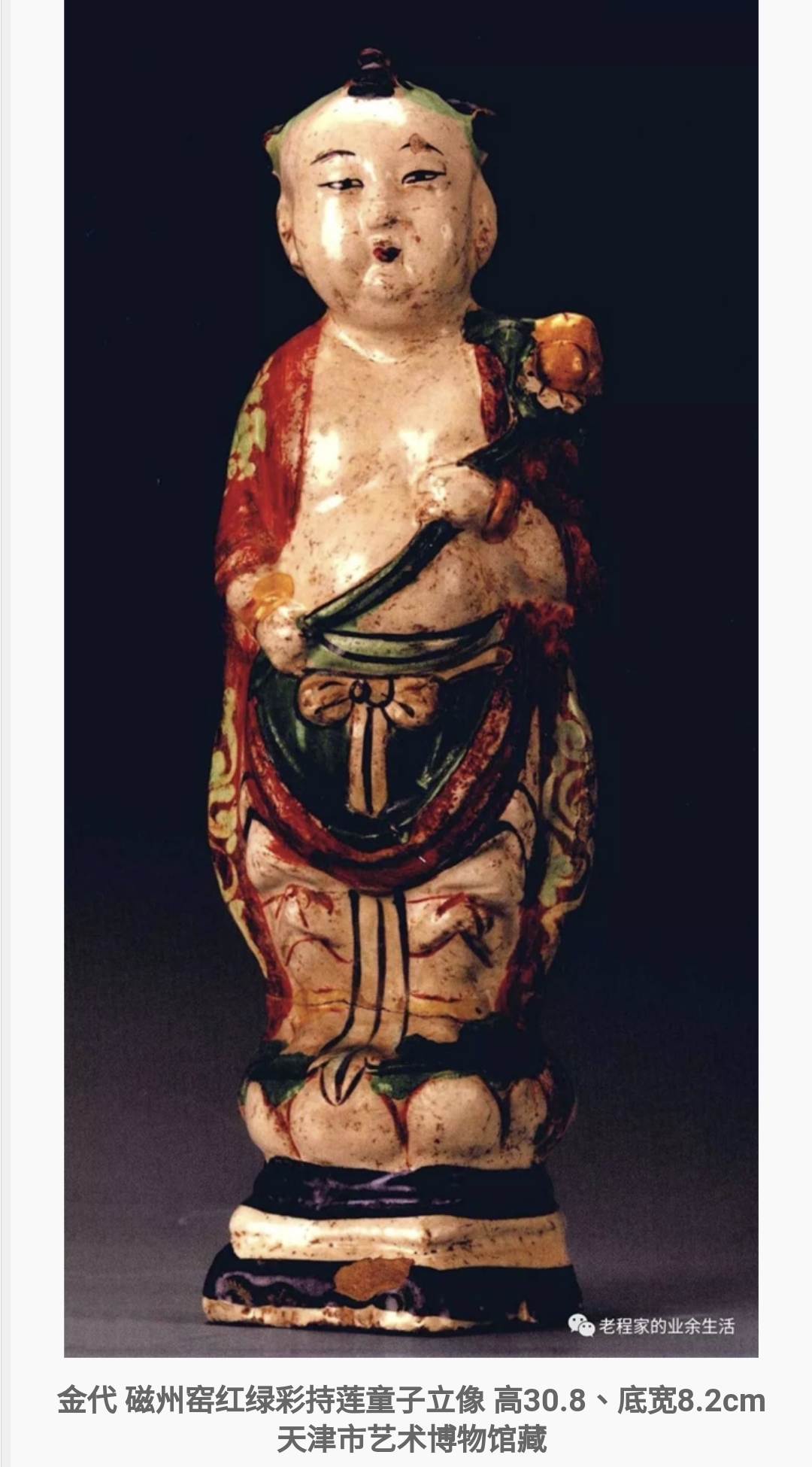 |
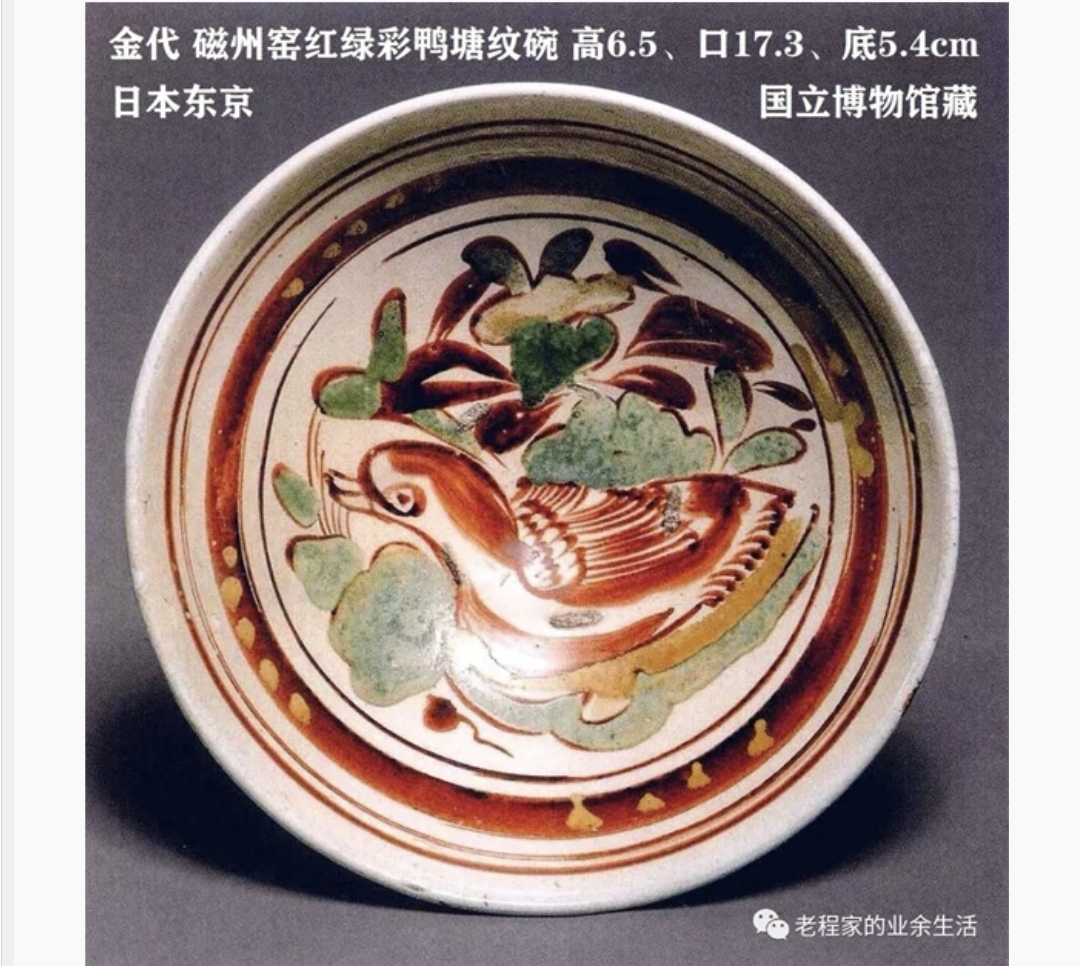 |
| Jin vessels with green,red and yellow overglaze enameled decoration |
There were further development of overglaze enamelled wares during the Yuan, Ming and Qing Dynasty and subsequently evolved into the widely known Ming/Qing wucai .
For more on Cizhou ware, please read: Cizhou wares
Black wares
Jian (temmoku/Tianmu) ware
Jian black wares were made in Jian kilns situated in shuiji Jianyang (ˮ��������in Fujian province. Its major products were black glazed tea bowls with purplish black paste. The most famous type had hare's furs effect on it. The hare's furs are streaks which are either brownish or silvery white in colour. Some highly priced type have bluish irridescent oil-spots of different sizes and shapes in the glaze.��Those made for the palace had the inscribed chinese characters gongyu (������or jinzhan ����յ����mark.
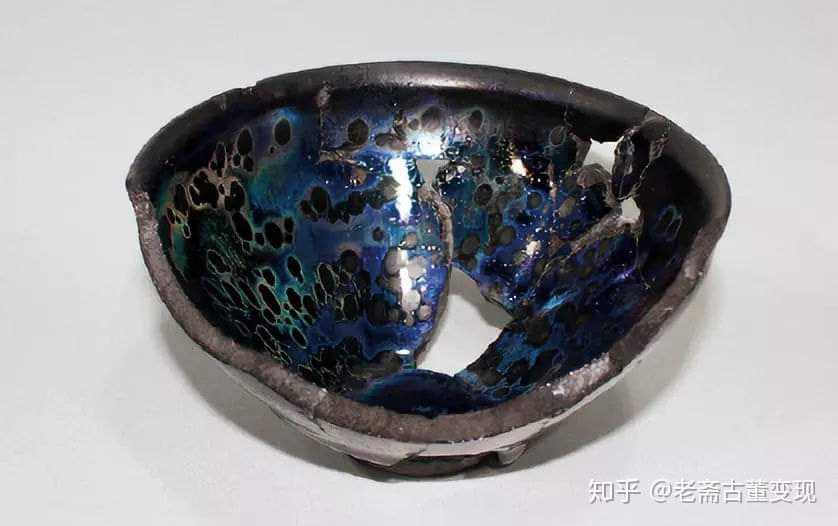 |
| Song Yohen Temmoku from the ancient State Guest House site in Hangzhou |
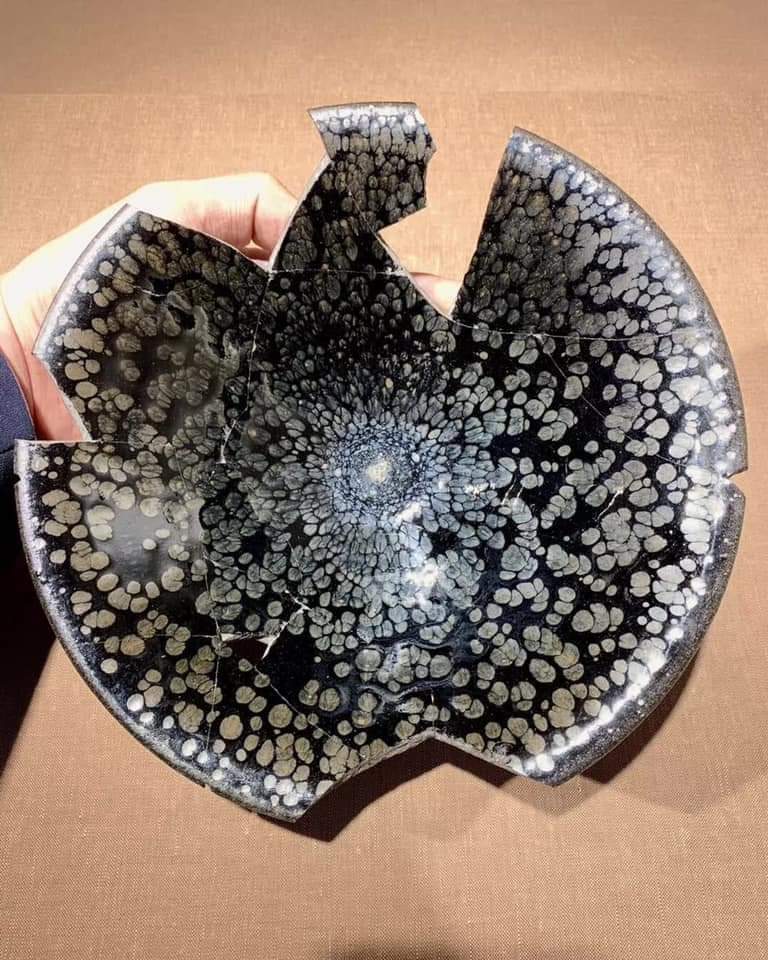 |
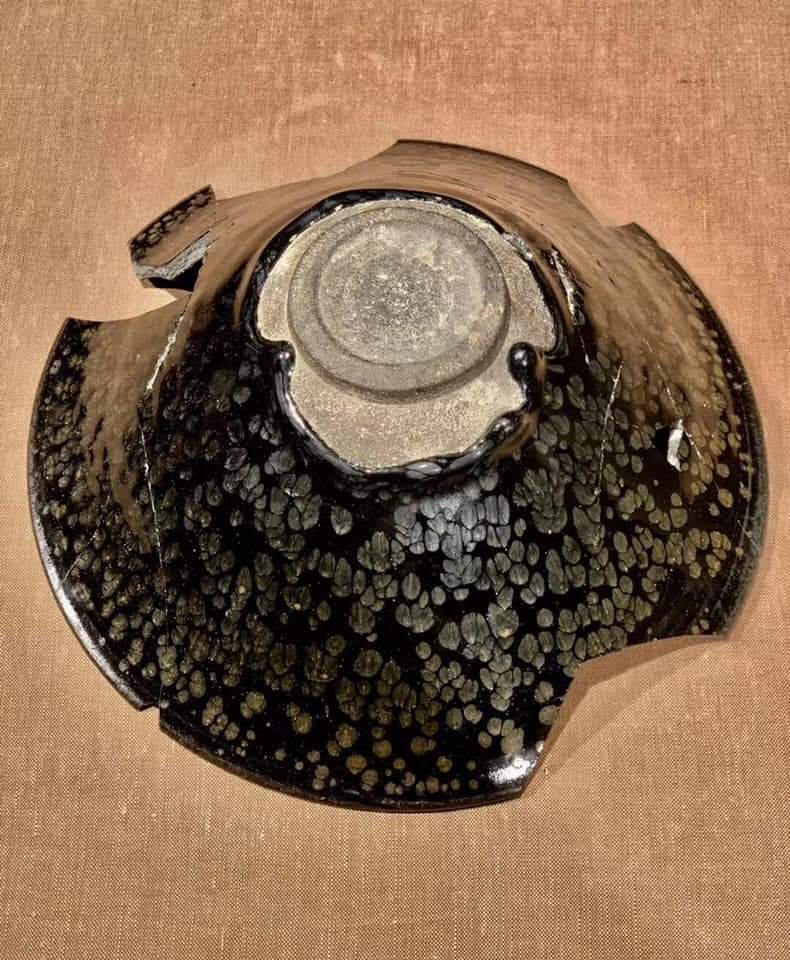 |
| Song Jian oil spotsTemmoku bowl |
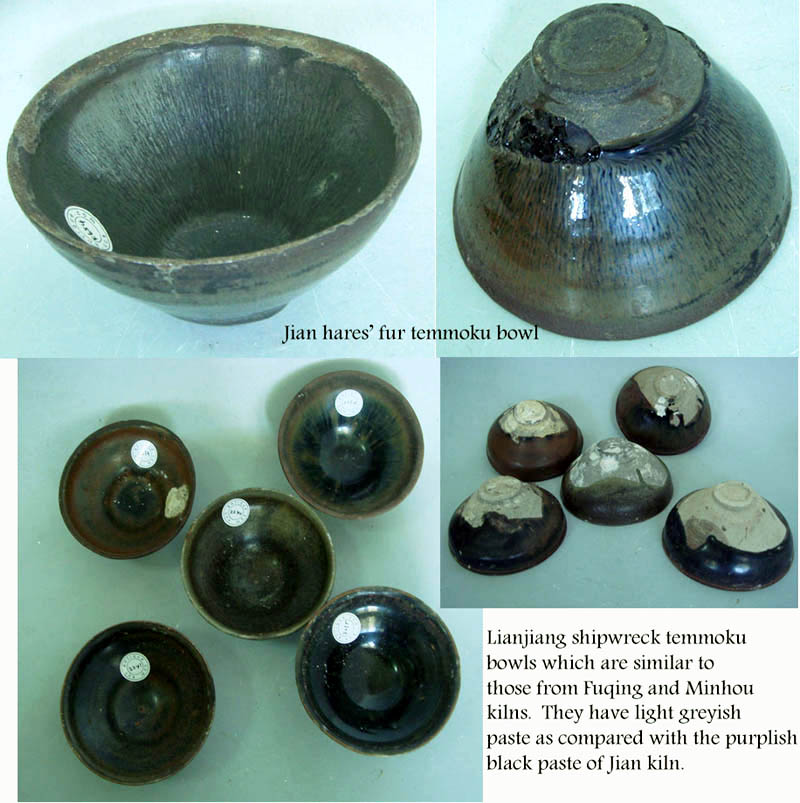
Tea contest was popular during the Song Dynasty. Jian tea bowls were considered most suitable for such contest as its glossy black surface contrasted well with the white tea.
During the Song Dynasty, the monasteries in the Tianmu mountains were frequently visit by Japanese monks who took the black tea bowls used in the monasteries with them when they returned home. Hence black tea bowls came to be known as Tianmu (temmoku) in Japan.
For more on Jian Temmoku bowl, please read this article.
Jian tea bowls were in high demand during the Song Dynasty and numerous kilns in Fujian also produced them to meet the demand. There were also other kilns in provinces such as Zhejiang, Jizhou and sichuan which produced them.
Such bowls continued to be produced for sometime into the Yuan period.
For more information on Non Jian Fujian temmoku, please read: Lianjiang shipwreck Fujian temmoku bowls
Northern China black/brown wares
Northern kilns such as those in Henan and Hebei also produced beautiful oil spots black glaze tea bowl. The Yaozhou and Ding black and Zijing glaze wares were also high excellent. Henan kilns also made black wares with iron rust effect design of floral/bird and splashed design. The black glaze was first applied and then the design painted over the glazed surface using iron-rich pigment. The ware was fired at about 1300 degree centigrade and the iron pigment transformed into haematite crystals which is rust red in colour.
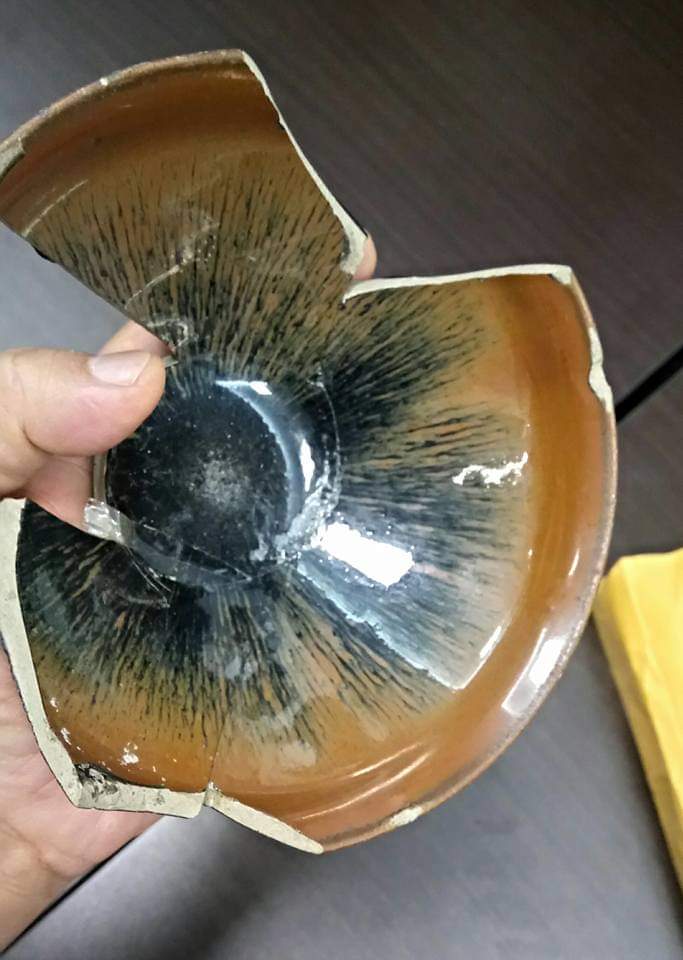 |
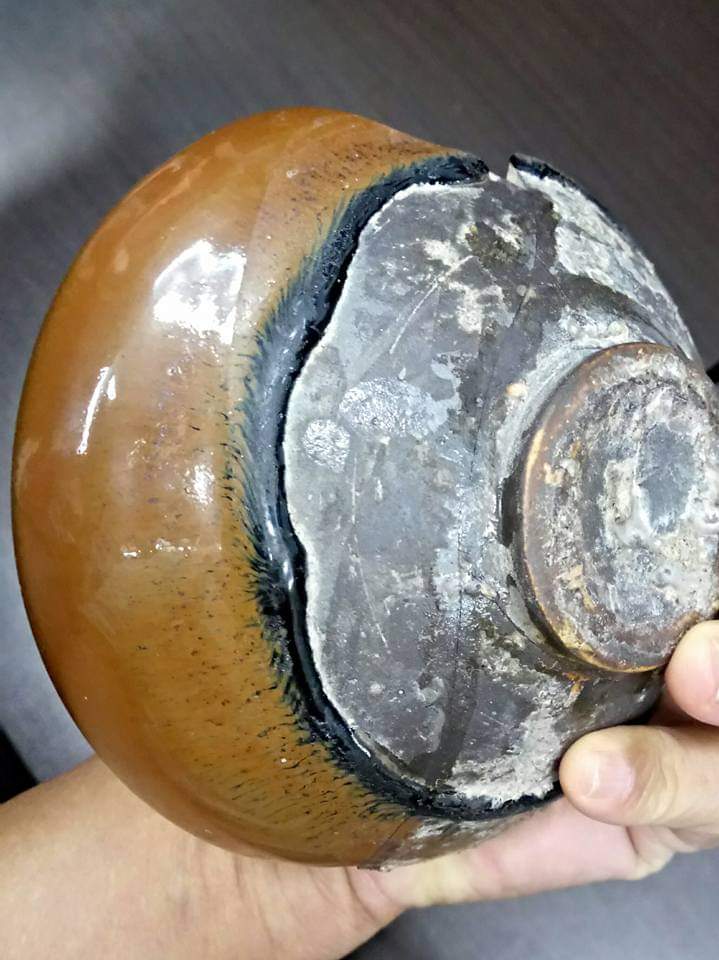 |
| Song Cizhou example with hare's fur effect. The expose base is coated with a black slip. |
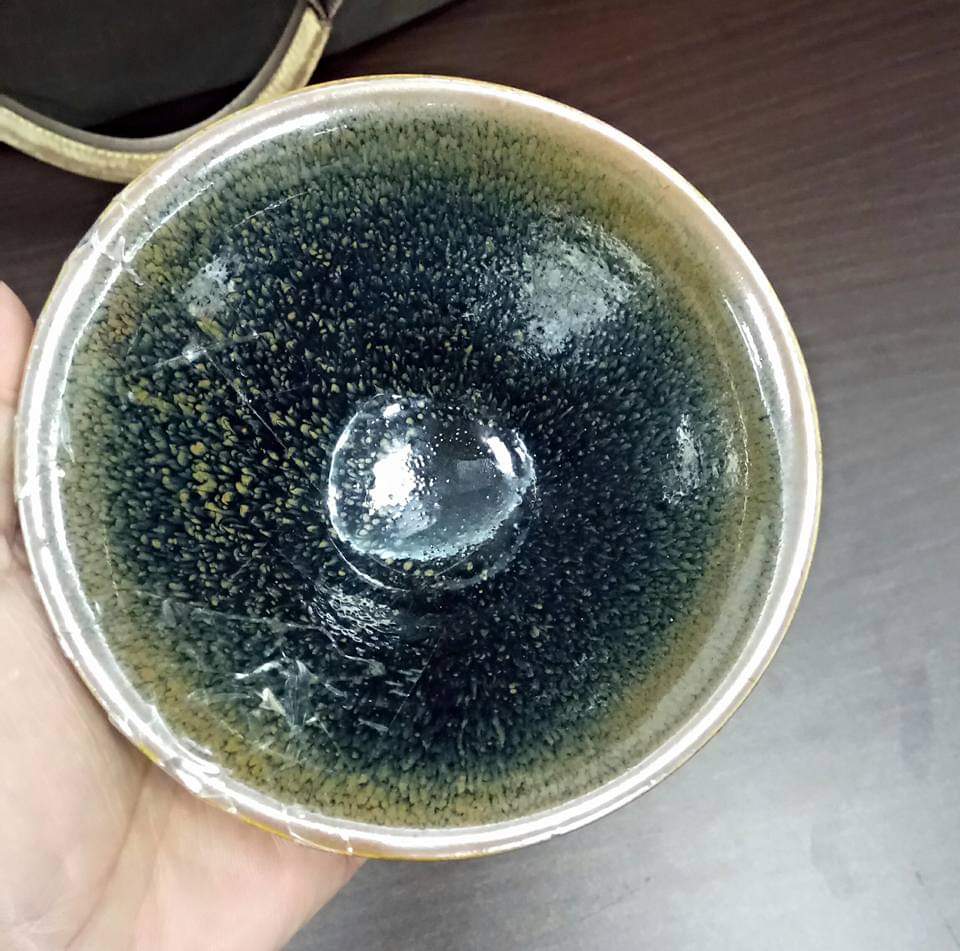 |
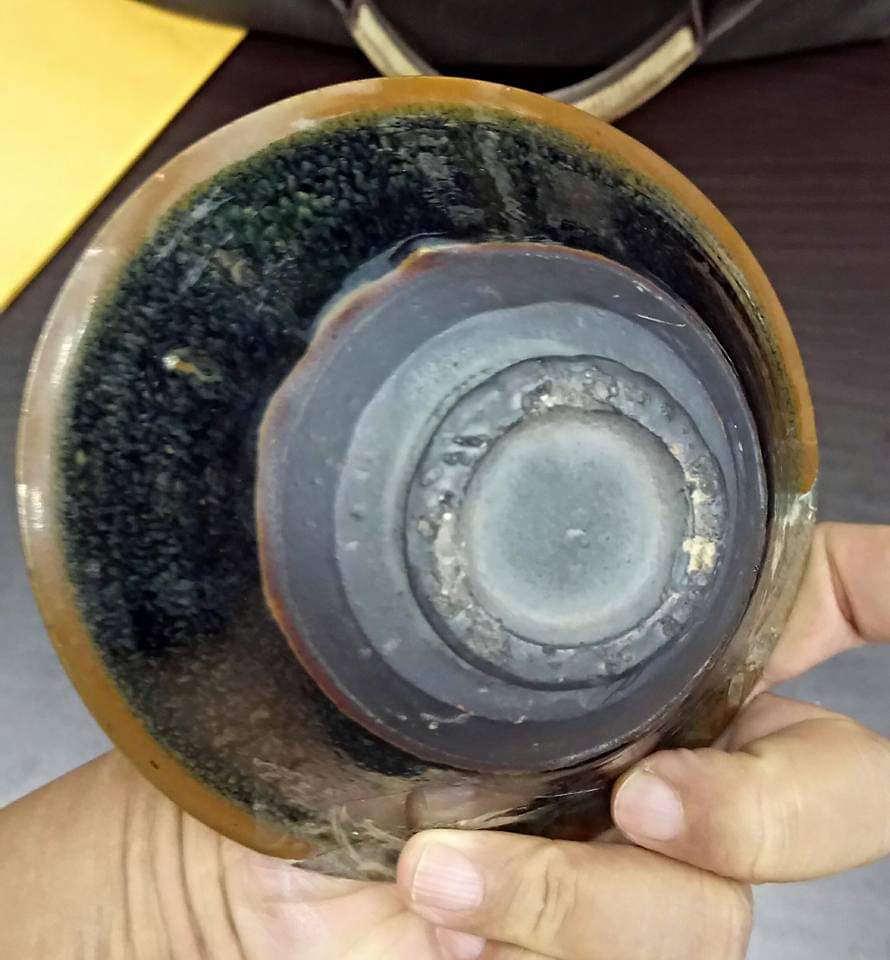 |
| Another Song/Jin Cizhou temmoku bowl |
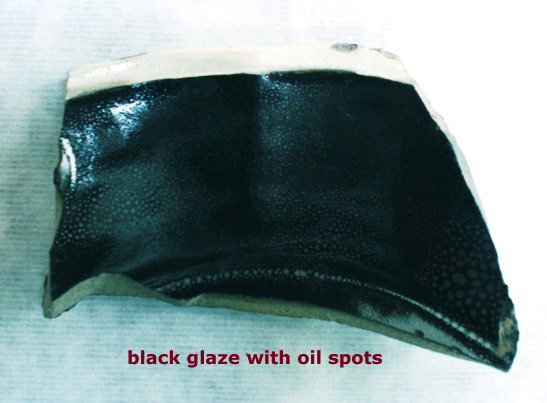
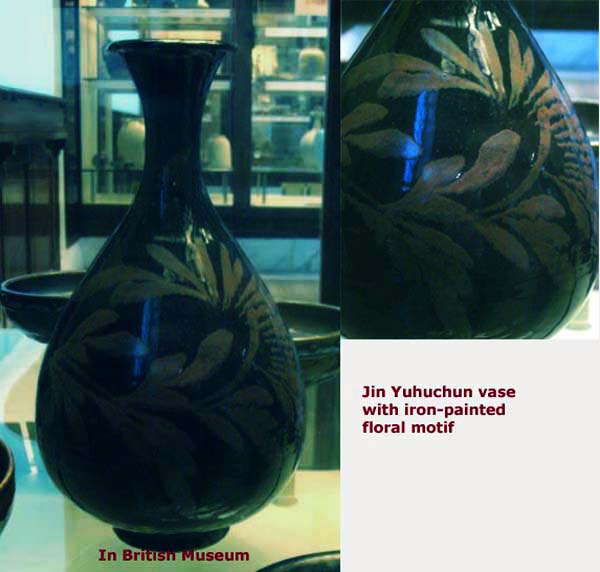
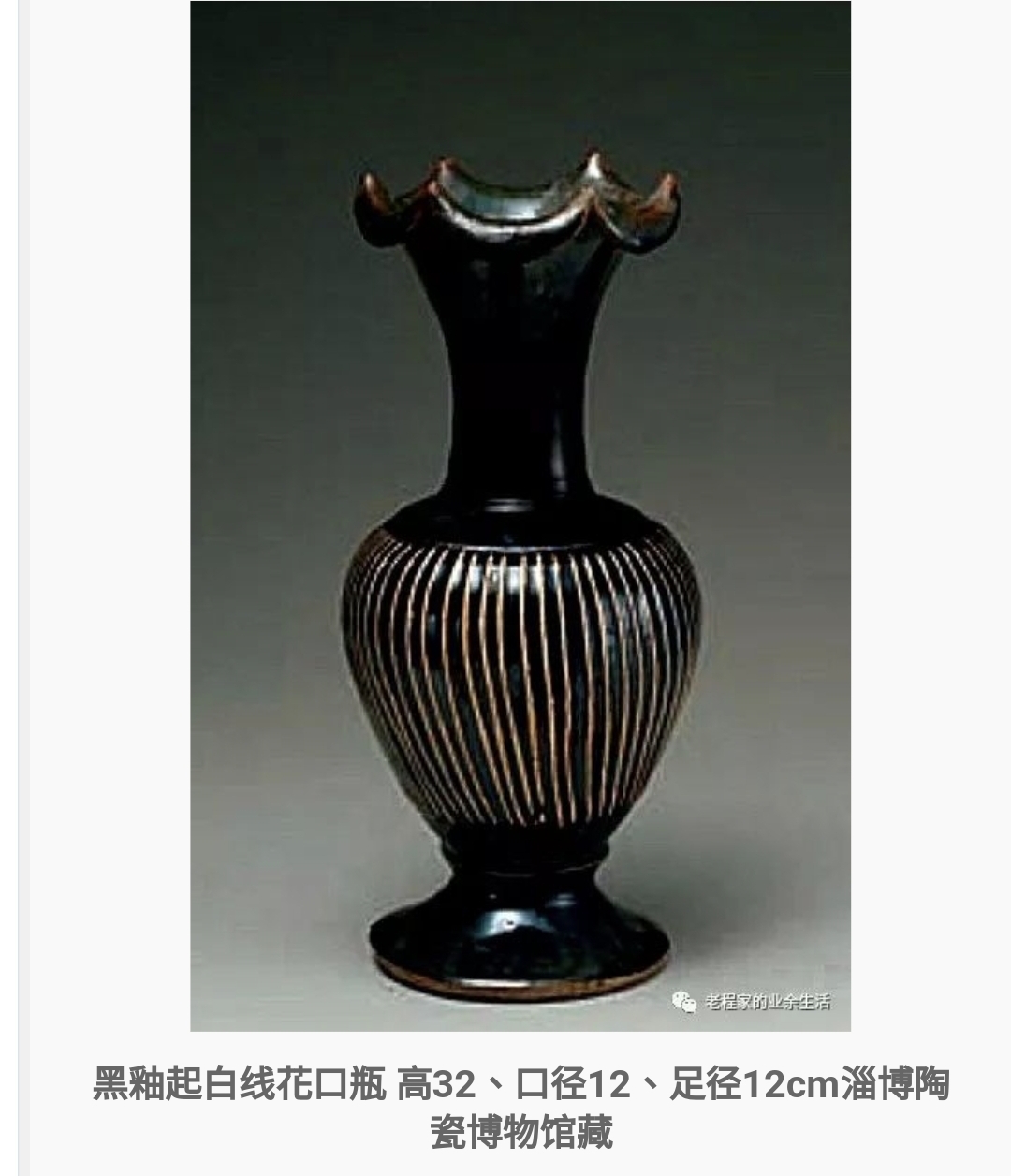 |
| Jin Cizhou black glaze with ribbed body |
Jizhou ware
Jizhou kiln is situated in Yonghe in Jiangxi province. During the Southern Song period, Jizhou kiln developed a distinctive decorative technique which involved sprinkling a lighter glaze over a darker base glaze to produce the so called the tortoise shell and tiger fur effects. They may have a dry mouldy mottled quality or could be more transparent and glossy if fired at a higher temperature. There were many other varieties of mottled effect.
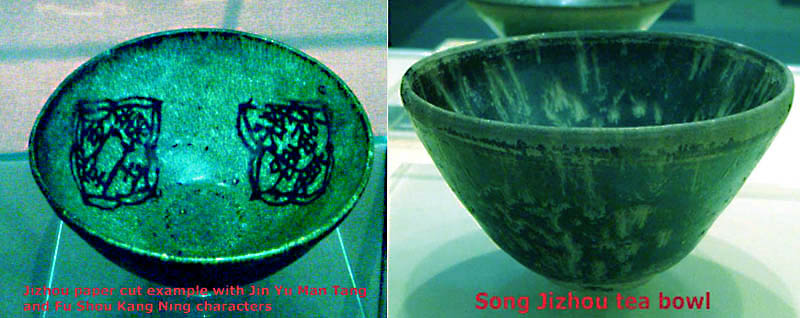
The Jizhou potters also used paper cuttings for decorations. The openwork stencils of cut paper was positioned on the dark glaze surface. A lighter glaze is then sprinkled over the whole surface. A black design on a lighter colour mottled background is produced when the paper cutting is removed. Some more commonly found papercut designs include plum blossom, floral spray, dragon, and phoenix. There are also those with rhomboid patterns and 4 Chinese characters such as fu shou kang ning literally meaning fortune, longevity, health and peace or chang ming fu gui ie long life and prosperity.
During the late Song period, Jizhou also produced the underglaze iron-brown cizhou type painted motifs vessels.
For more on Jizhou ware, please read: Jizhou wares
Liao wares
Another important production site was in regions ruled by the Liao Dynasty. The dynasty was founded by a Khitan leader, Abaoji in 916 A.D, towards the end of Tang Dynasty. The Liao dynasty eventually fell to the Jin dynasty of the Jurchen in 1125. Hence, Liao ceramics were contemporaneous with 5 Dynasties to Northern Song phase. In fact, the golden period of Liao ceramics production was during the Northern Song period.
Famous Liao kilns included Chifeng (赤峰)in Inner Mongolia, Shanxi Hunyuan jie Zhuang (山西浑源界庄), Liaoning Liaoyang gang guandun (辽宁辽阳冮官屯) and Longquanwu kiln (龙泉务窑) kiln in Beijing. Basically, Liao ceramics share much similarity with Ding and Cizhou wares in terms of glaze, decorative styles and vessel forms. As an indication of the identity problem, Chinese ceramics experts still face difficulties in deciding whether some of the vessels found in Liao graves were actual Liao products or from Cizhou or Ding kiln. Incised characters such as "guan" (官)and "xin guan" (新官)were also found on some Liao wares.
Besides high fired white wares, Liao potters also produced green, black wares wares. There are also low fired lead glaze green/yellow/white and sancai wares. Distinctive Liao wares include those phoenix head ewers and cockscomb flasks. Those vessels were unique to the Khitan nomadic race. The coarser white wares were covered with white slip but the fine ones were without.
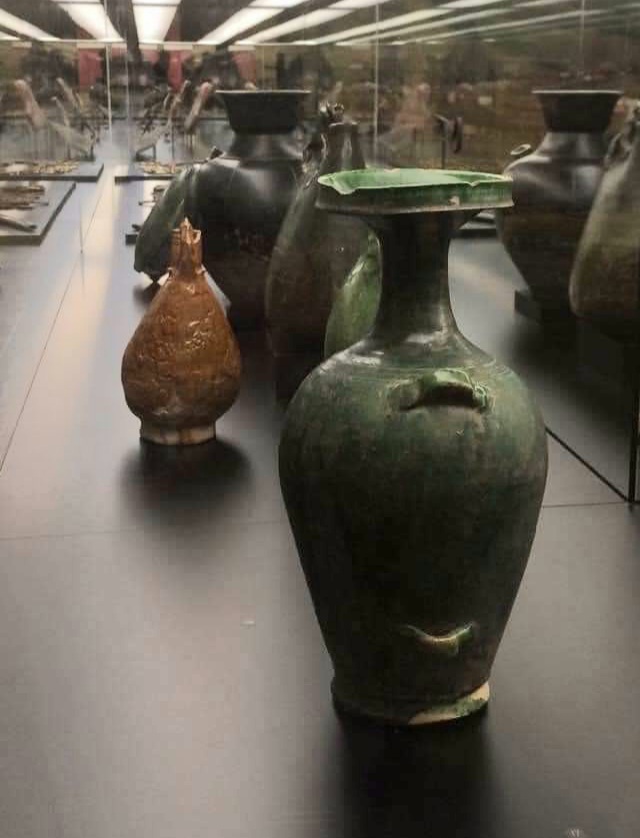 |
||||||||||||||
| Liao Green glaze vase (938 - 968 A.D) | ||||||||||||||
|
Updated by : NK Koh (2 Oct 2021)